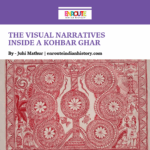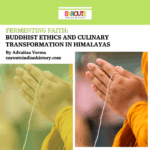Poetic spaces and painterly legacies: The visual narratives inside a Kohbar Ghar
- iamanoushkajain
- June 14, 2025
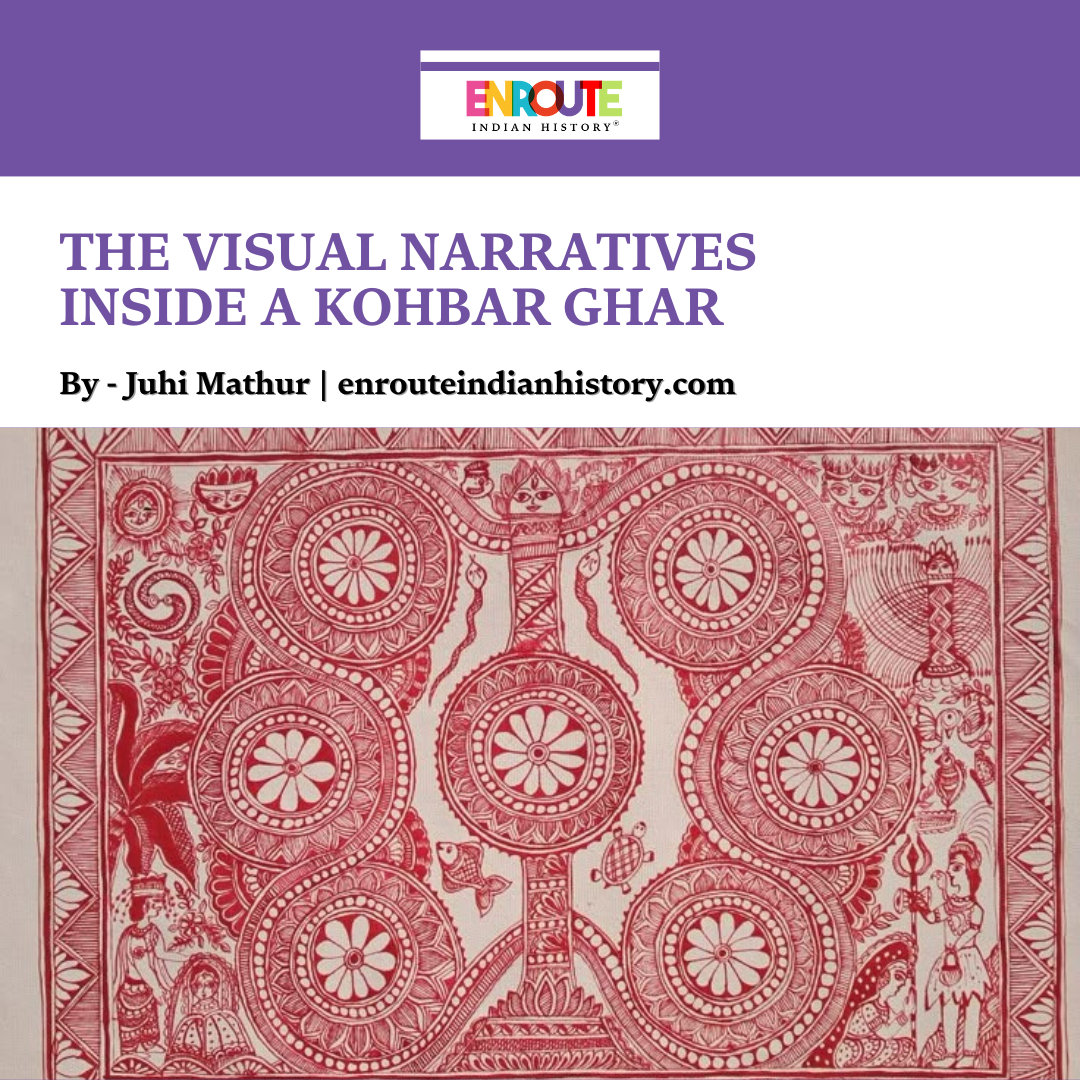
By Juhi Mathur
Does life imitate art or does life delineate and dictate artistic expression? Since time immemorial, there has been an intricate relationship between ritualistic ceremonies and visual culture that accompanies it. Walking into the house of the bride, nestled in the Mithila region of Bihar, we stand across the vibrant imagery of the Kohbar Ghar or the nuptial chambers which are created by the women of the community. The main premise is to delineate the stories of Kohbar ghar, with its narrative visuals which bring to life old age folklores, while unearthing the role of women in its conception. Predominantly found in the region of Mithila, and focusing on the visual vocabulary that has been developed by the Mathil Kayasthas.
To understand the concept of Kohbar, it is first important to understand the difference between a consecrated space and an ordinary space. Painting patterns and creating stories plays a big part in the creation of a space that is sanctified and pure and invokes their ancestral gods and gods in the Maithil community. In the Kohbar, the stories become part of rituals, it is a nuptial chamber that denotes the beginning of new life, where the bride and groom become protagonists of the story and they embark on a new journey together.
The etymology of the word Kohbar is shrouded in mystery, it is predominantly used in the eastern regions of Uttar Pradesh, and in Bihar, specifically denoting symbols that are drawn on the walls of the nuptial chambers. Among the Kayasthas of Mithila region, Kohbar usually means the motifs of the nuptial chamber which showcase the stylised form of lotus bud or kamaladah and stem which is also known as Purain. The Kohbar also denotes the wrapping paper for vermillion which is sent by the bridegroom, the wrapping paper also has the lotus stem drawn on it which is similar to the central motif found in Kohbar mural. Therefore, it is usually concluded that Kohbar is correlated to the motif of the lotus.
The preparation of Kohbar ghar is usually done on a specific day that is chosen by the purohit. The wall facing the east is first covered with rice paste, the act itself is sacred in nature, transforming the space into a venerated shrine of worship. Once the ground is prepared, the process of painting begins with tip lagavaichi or putting the red dot which serves as the central point for lotus medallion. This ritual is usually performed by ahibati or a married woman, and this act of painting on the wall turns the whole space into a sanctified territory, making it a part of the divine realm that is used to bless the newly married couple.
Symbolisms in the mural: What is more fascinating is the central motif of the kohbar ghar and the stories that are connected to it. The central drawing of kohbar ghar has become the structural part of the narrative and can be seen in the modern iterations as well. The lotus buds are personified and represent the bride and the bamboo stems piercing through the buds represent the bridegroom encapsulating the theme union in marriage. Throughout all the marital rituals, the lotus symbol is a revered entity that is worshiped by the groom and bride, by putting vermillion on it. In the mural, the lotus symbol remains consistent while the stems, and the flora and fauna that surrounds it, undergoes innovation as per the ideas of the artists.
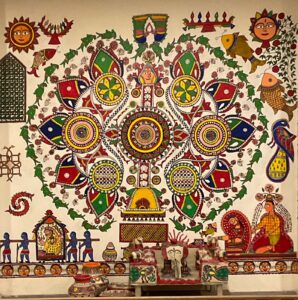
The bride and groom spend the first four days after the wedding inside this nuptial chamber. It was first thought that Kohbar was the symbol of sexual union. In many ways Kohbar presents the bride and she is worshiped by her husband. The indoor spaces of a domestic chamber are festooned with blooming vines presenting fauna and flora as signifiers of fecundity and thriving marital bliss.
Motif of Naina Jogin: Adding to the layer of magical realism to concept of Kohbar ghar murals is the presence of naina jogin, she is the revered goddess of protection who wards off evil eye. In every kohbar ghar mural naina jogin is drawn in the four corners as a symbol of protection, keeping the union safe and intact.
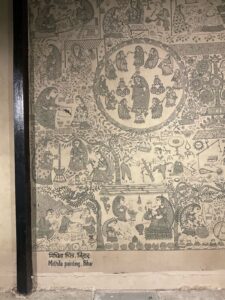
Iconographically, naina jogin motif has been carried over through generations, and it has shown the goddess with long hair holding a basket of paddy and dried turmeric roots, with her whole face covered with a saree,leaving only her eye and a portion of the left side of the face visible. This motif showcases continuation in imagery elements that make kohbar ghar stories are visual as well as an oral tradition that is passed down through generations.
Matrilineal aspect of Kohbar Ghar: The creation of Kohbar ghar is a communal effort, and the conception of pictorial space is done by the group of women from that community. One of the famous artists from the Mithila region Ganga Devi has observed that each Kohbar ghar has a personal touch of the women who create them. The painting of the kohbar ghar and the walls flanking its entrance are all drawn by women, as part of the wedding preparation. The iconographic features and the stylistic components are conceptualized by the main artist who is a distinguished women artist. The auspicious day is chosen to paint the kohbar by consulting a purohita and the painting process is commenced. The main wall of the kohbar-ghar, which faces east, is white-washed, and then covered with rice paste applied by a cloth dipped in the paste. The very act of smearing the wall with rice paste is an important ritual event, transforming a mere domestic wall into a sacred space in the same way as an ordinary floor acquires magical
properties, necessary for sacred installations to be placed upon it, through aripan diagrams executed with rice paste.
After the main wall of the kohbar-ghar is thus sanctified, an auspicious beginning to the painting is done by tip lagavaichi or putting a red dot at the centre of the wall, which also serves as the mid-point of the central medallion of the central lotus plant motif. This ceremony may be performed only by an ahibati, a married woman whose husband is still alive. Usually the leading painter herself performs this ritual act, but in the event of her being a widow, the task of tip lagavaichi is performed by a married woman.
On this occasion, five women of the family sing ele subh ke lagan subhe ho subhe, 'let there be all round auspiciousness in the auspicious wedding'.
According to Ganga Devi, the central wall is filled with symbols of kamaldahs, bans, kohbar, and aripan while the walls beside it consists of narrative stories that showcase Krishna and cowherdesses, Shiva and Parvati, henceforth bringing together the symbolic-narrative style of Kohbar.
Iconographic motifs: The most fascinating features from the kohbar’s multifaceted world of symbols are bamboo (bans), Naina jogin, latpatia suga, nag-naagin, bidh-bidhatha. Each motif symbolises a distinct part of Mithila culture specifically focusing on the union of divine feminine and divine masculine.
Conclusion: Each aspect of Kohbar ghar symbolizes a myriad of rituals which are part of the wedding ceremony of the community. They are safeguarded by the women of the community who have continued with these traditions over generations, the act of painting the walls to sanctify the spaces, to create spaces that connected with matrimonial practices, and to communicate their understanding of the spiritual world through visual motifs is what distinguishes the practice of creating Kohbar ghar. In the 1980s when the development of the National Crafts Museum was in its nascency, Ganga Devi created the Kohbar ghar in the museum, which is presented as an anthropological relic of the Mithila region.
There is an inherent celebration of life and companionship that Kohbar represents in the grander scheme of things. With this paper, I want to present the elaborate meanings of these motifs under a lens of spiritual themes that have existed through the prevalent goddess worship in the Mithila region. The world that is created by the women in the domestic spaces for the newly wedded couple to help them understand the sanctimonious nature of their marriage, as well as to protect them from any harm. This showcases their reverence towards their gods and how they view each part of the natural world as an extension of it, with my paper I want to lead the viewers on a walk through the chambers, unearthing the rice-paste covered walls that seek to connect with the mother nature and spiritual protectors through the performative acts of creation and expression.



